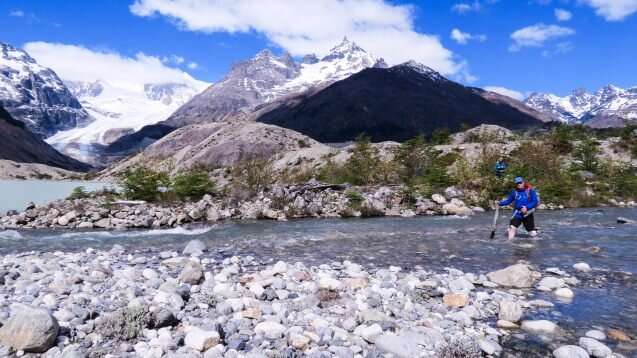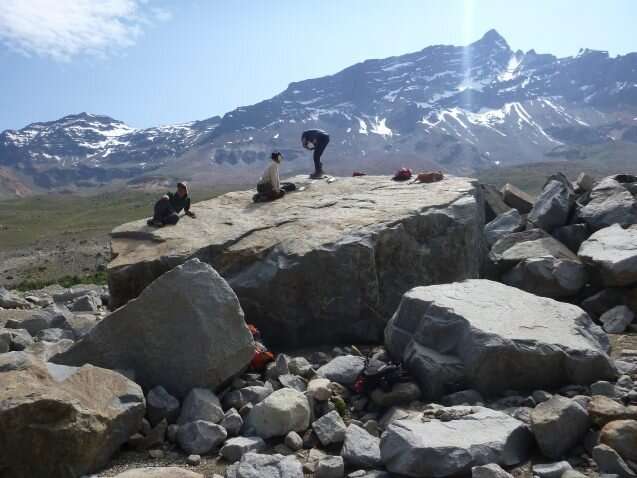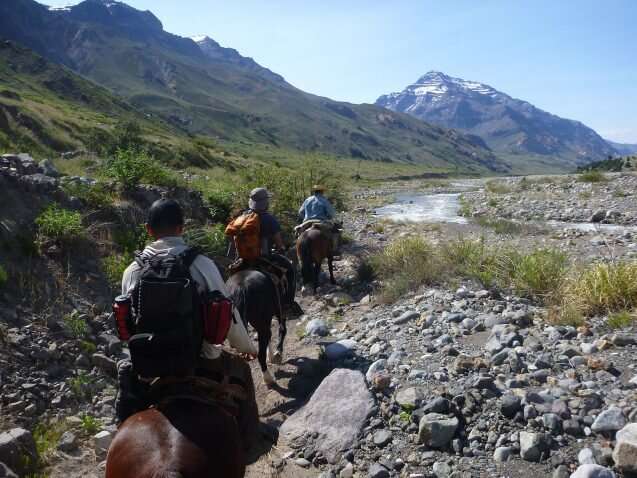Ghosts of glaciers past hint at future climate challenges

In order to predict how glaciers will respond to climate change in the future, scientists first need to understand how they've responded in the past. A team of scientists in the Cosmogenic Nuclide Lab at Columbia University's Lamont-Doherty Earth Observatory have taken on the challenge by studying glacial remains all around the world, from Patagonia to the Arctic.
One of the most interesting questions that the team is investigating is whether glaciers in different latitudes and hemispheres expand and retreat at similar times, said Mike Kaplan, a Lamont research professor who works in the Cosmogenic Nuclide Lab. Prior to human influence, there are strong indications that climate patterns affecting the southern hemisphere glaciers were out of step with those in the north, said Kaplan, and understanding why could help project the effects of modern climate change.
Reconstructing the Past
Studying glacier retreat that happened more than 11,000 years ago can be tricky.
To do so, the team uses a method called cosmogenic dating. For the method to work, scientists must first identify a well-preserved mass of rocks or sediment left behind by a shrinking glacier that is called a moraine. Then, scientists chip away sections of the boulders in the moraine to take back to the lab, where they can be analyzed for the presence of beryllium-10, an isotope that is formed from cosmic rays in Earth's atmosphere.

Counting atoms of beryllium-10 on the rocks' surface helps scientists to determine exactly how long the rock was exposed to the atmosphere, or how long ago it was uncovered by ice. This helps to create a timeline for glaciers expanding and retreating, and ultimately, reveals how the climate changed over time. During the last 10 years, researchers with the Cosmogenic Nuclide Lab have used cosmogenic dating to document the ghosts of glaciers on more than five continents, including Europe, South America, Antarctica, Australia, and North America.
"Most of our knowledge about temperature changes on Earth come from ice cores in Antarctica and in Greenland," said climate geoscientist Joerg Schaefer, who leads the lab. "But those are both in very extreme positions—they are both polar. In between, it's really hard to find reliable, accurate thermometers, and mountain glaciers basically fill that gap."
For the last several years, the group has mapped glacial remains of the Patagonia Ice Sheet near the Strait of Magellan area in southern Patagonia. There, research led by graduate student Carly Peltier turned up evidence that, during the last glacial period, the Magellan ice lobe would have reached a position more than 65 kilometers further east than previously reported, providing important new data for paleoclimatic reconstructions. Retreat from this maximum glacier position began slowly by 25,000 years ago, with the ice continuing to stabilize repeatedly until about 18,000 years ago, which was then followed by rapid, irreversible retreat. By 16,000 years ago, the Patagonia Ice Sheet had more or less disappeared in southernmost South America.
With support from the National Science Foundation, the team most recently went back to South America in November 2019, this time to study and compare historic glacier retreat more in the central Andes mountain range over the last 11,000 years. The idea is to determine whether glaciers at different latitudes experienced similar expansions and retreats over this same time period. For the latest study, Kaplan and three Chilean colleagues traveled by horse for nearly two days to sample a remote site in the central Andes. There, they collected more than 35 moraine specimens to bring back to the lab, where they will analyze their chemical makeup and compare them to specimens the lab group have taken over recent years in the southern Andes in Chile. COVID-19 delayed the analysis of the newest samples due to the closing and then phased re-opening of labs this year, but Kaplan hopes to start soon.
"With this project, we're moving north slightly in South America to see if the same patterns and changes that we've seen over the last 10 or 15 years [of our group's research] continue as you go north," said Kaplan. "One of the things we're trying to understand is what caused glacier variability in a natural sense before human effects on the climate system."

Painting a Picture of the Future
Over the last few decades, the impact of human activities on climate change and ultimately, glacier retreat, is undeniable, according to Kaplan and Schaefer. Activities such as deforestation and the burning of coal and other fossil fuels led to an increase of carbon dioxide into the atmosphere, where it hugs the planet like a scarf, leading to a steady rise in global temperatures.
Provided by Earth Institute at Columbia University
This story is republished courtesy of Earth Institute, Columbia University http://blogs.ei.columbia.edu.





















